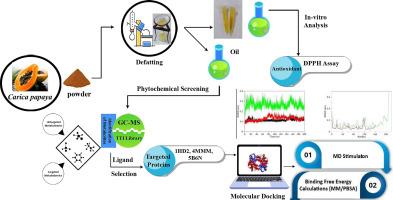Phytochemical profiling, antioxidant potential, and in silico evaluation of Carica papaya seed oil
IF 4.2
Q2 CHEMISTRY, MULTIDISCIPLINARY
引用次数: 0
Abstract
Carica papaya seeds, traditionally used in folk medicine, have garnered scientific interest due to their potential therapeutic properties. The study investigates the antioxidant potential and compound composition of Carica papaya seed oil. Utilizing GC–MS analysis, we identified 42 significant compounds in the n-hexane fraction of the oil, with notable constituents including benzyl nitrile (3.43 %), pentadecanoic acid 14-methyl-methyl ester (5.23 %), and n-hexadecanoic acid (7.11 %). The antioxidant activity of the oil was assessed using DPPH radical scavenging assays, revealing a maximum inhibition activity of 61.13 % at a concentration of 100 mg/mL, compared to 76.23 % for the standard vitamin C. For further precise binding pose predictions, Schrödinger's Glide module was used for molecular docking. Docking scores and molecular interaction profiles were used to evaluate binding interactions after the produced ligands were docked into the receptor grid. The greatest docking score (−6.657) was shown by 6-chloro for 5B6N, 1H-Indole-2-carboxylic acid, which formed hydrogen bonds with PHE 207 and VAL 187, two essential residues for ligand stabilization. Further, the molecular dynamics simulation study disclosed that the complexes of the relatively active phytoconstituents with the target structures were stable. These findings highlight the therapeutic potential of Carica papaya seed oil as a natural antioxidant, suggesting its viability for further research and application in health-related fields.

番木瓜籽油的植物化学分析、抗氧化潜力和计算机评价
番木瓜种子传统上用于民间医学,由于其潜在的治疗特性而引起了科学界的兴趣。研究了番木瓜籽油的抗氧化作用及其化合物组成。利用GC-MS分析,我们在油的正己烷部分鉴定出42种重要化合物,其中主要成分包括苯腈(3.43%)、五酸14-甲基甲酯(5.23%)和正十六酸(7.11%)。利用DPPH自由基清除试验评估了该油的抗氧化活性,结果显示,在100 mg/mL浓度下,该油的最大抑制活性为61.13%,而标准维生素c的抑制活性为76.23%。为了进一步精确地预测结合姿态,使用Schrödinger的Glide模块进行分子对接。对接分数和分子相互作用谱用于评估所产生的配体与受体网格对接后的结合相互作用。6-氯与5B6N, 1h -吲哚-2-羧酸的对接得分最高(- 6.657),与PHE 207和VAL 187形成氢键,这是配体稳定的两个必要残基。此外,分子动力学模拟研究表明,相对活性的植物成分与目标结构的配合物是稳定的。这些发现突出了番木瓜籽油作为天然抗氧化剂的治疗潜力,表明其在健康相关领域的进一步研究和应用的可行性。
本文章由计算机程序翻译,如有差异,请以英文原文为准。
求助全文
约1分钟内获得全文
求助全文

 求助内容:
求助内容: 应助结果提醒方式:
应助结果提醒方式:


